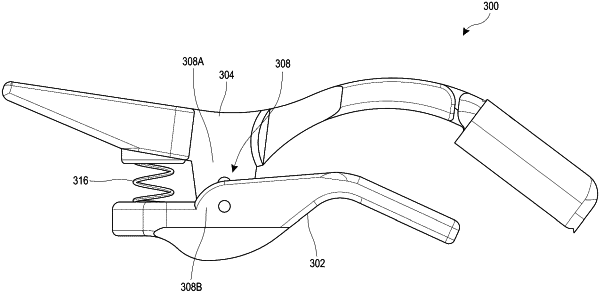| CPC A61B 5/6819 (2013.01) [A61B 5/0205 (2013.01); A61B 5/02427 (2013.01); A61B 5/0816 (2013.01); A61B 5/14532 (2013.01); A61B 5/14546 (2013.01); A61B 5/14551 (2013.01); A61B 5/7445 (2013.01); A61B 5/746 (2013.01); A61B 2562/0242 (2013.01)] | 20 Claims |

|
1. A physiological sensor configured to be secured to a portion of a user's nose, the physiological sensor comprising:
an upper sensor body comprising a front portion, a rear portion, and an intermediate portion extending between the front and rear portions, wherein the front portion is planar;
a lower sensor body comprising a front portion, a rear portion, and an intermediate portion extending between the front and rear portions, wherein the front portion of the lower sensor body is planar;
an emitter configured to emit light of one or more wavelengths towards tissue of the user's nose when the physiological sensor is in use, wherein the emitter is operably positioned by the front portion of the upper sensor body;
a detector configured to detect at least a portion of the light emitted from the emitter after attenuation through the tissue of the user's nose when the physiological sensor is in use, wherein the detector is operably positioned by the front portion of the lower sensor body and is further configured to the generate one or more signals responsive to the detected at least the portion of the light; and
a joint configured to rotatably couple the upper and lower sensor bodies together and allow the upper and lower sensor bodies to rotate with respect to each other between a first position and a second position, the first position being a neutral position of the physiological sensor, wherein the front portions of the upper and lower sensor bodies are closer to each other when in the first position than when in the second position;
wherein the intermediate portions of the upper and lower sensor bodies cooperate together to form the joint;
wherein the upper and lower sensor bodies are biased toward the neutral position;
wherein the intermediate portion of the upper sensor body comprises a first portion and a second portion, the second portion being positioned between the front portion of the upper sensor body and the first portion of the intermediate portion, the first and second portions of the intermediate portion defining a concave portion having an apex;
wherein the upper sensor body curves away from the lower sensor body at the first portion of the intermediate portion and curves toward the lower sensor body at the second portion of the intermediate portion thereby causing:
a first plane defined by the planar front portion of the upper sensor body to be transverse with respect to a second plane defined by the planar front portion of the lower sensor body when the upper and lower sensor bodies are in the neutral position; and
the first plane defined by the planar front portion of the upper sensor body to be parallel with respect to the second plane defined by the planar front portion of the lower sensor body when the upper and lower sensor bodies are in the second position;
wherein a first distance from the joint to the apex is greater than a second distance from the joint to a start of the front portion of the lower sensor body.
|